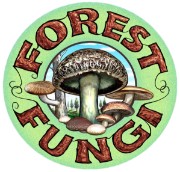Mycopermaculture
Permaculture and Mycology
Fungi are already at work in Permaculture systems everywhere. It is in our interests to better understand the roles they play, and to work with them There is virtually no limit to the guilds we can create that incorporate fungi, and this area of study is evolving rapidly. When fungi and plants enter into mycorrhizal relationships, they tend to do so symbiotically, in order to sustain the relationship. Fungi obtain sugars and shelter, while the plants receive assistance in obtaining minerals, nutrients and water. The mycelia are very fine, and they effectively increase the plants access to available nutrients, spreading well beyond the root zone. Most plant species have mycorrhizal partners. One of the most prized foods, the Perigord Black Truffle (Tuber melanosporum), forms mycorrhizal relationships with Oaks and Hazelnuts, and it currently sells for $3000/kg! Most of the edible fungi we cultivate are Saprophytes. Saprophytes are decomposers, primarily of dead wood and vegetation, but also of manure, dead insects and other dead animals. They speed up the decomposition process, turning forest litter into soil. As an example Pleurotus eryngii – the King Oyster, is known to grow saprophytically in association with the roots of Eryngo-the Sea holly, which is in the Umbelliferaceae family. We can culture this delicious mushroom on a variety of substrates, and encourage a relationship in our gardens between The King Oyster and parsley, dill, chervil, celery, fennel, caraway, coriander, cumin , carrot and other umbells. We can harness the manure decomposers such as Coprinus comatus-the Shaggy Mane, Stropharia rugoso annulata- the Burgundy Wine Cap, and Agaricus brunnescens-the Portabella, amongst many others, to speed up the process of breaking down manure, thereby reducing unpleasant odours and fly breeding habitats. The fast cycling of nitrogenous wastes back into the soil also reduces potential water pollution from runoff. A compost pile can be viewed in a whole new way, once we begin to understand fungi. It needn't be a smelly old pile of debris, waiting to be turned, then more waiting before we get a yield. With a basic understanding of the requirements of just a few species of fungi, we can organize our composting to allow for multiple yields. If nematodes are a problem, why not allow Oyster mushrooms to hunt them down and devour them? Plants that are particularly susceptible to Nematodes, would benefit from this stealthy companion. Many other organisms enjoy consuming mushrooms, and we can organize guilds that bio-diversify our Permaculture systems. Some examples include:
- Growing worms, snails and various maggots on spent substrates and feeding them to chickens, ducks or fish.
- Growing species such as Stropharia rugoso annulata, The Burgundy Wine Cap, to supplement the diet of bees, which have been known to feed on the sugars contained in the mycelia.
- In an aquaculture system, mushrooms can also be utilized as myco-filtration units, helping to clean the water as it is cycled from the ponds back to the ponds. Yabbies are known to eat fungi and wood, they are classic decomposers, eating manure, meat, detritus, in fact just about anything. Spent mushroom logs and straw can be fed directly to yabbies by placing it at the edge of their ponds, partially submerged, and allowing the yabbies to decompose the pile at their own pace. The yabbies can then be eaten or fed to ducks or fish, or platypus if you’re lucky.
- Feeding mushrooms to pigs, well known lovers of fungi. Many Fungi have documented health benefits for humans, and some contain natural anti-biotics, immuno-enhancers, and adaptogens. Feeding them to our livestock can help keep them healthy naturally.
- We can also observe which Fungi animals seek out, and try and learn why. In this way, our ancestors discovered many foods and medicines-through observing the wisdom of nature.
Forest Fungi has developed mycopermaculture techniques incorporating mycology into every permaculture zone for high yield, soil nutrition, work minimisation, edible wild mushrooms and symbiotic relationships with other plants and vegetables. If you are interested in learning more, check out Forest Fungi Mushroom Courses.
